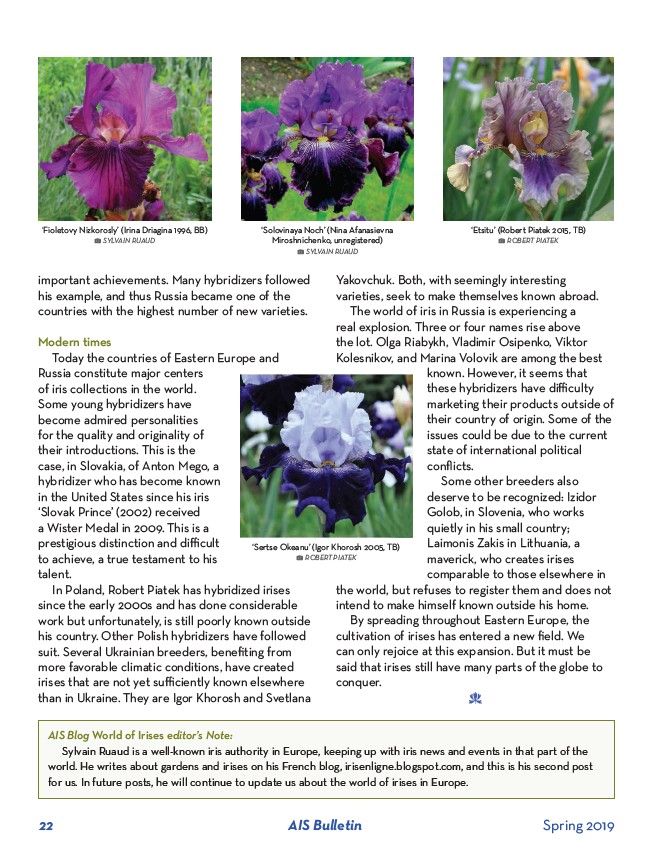
‘Solovinaya Noch’ (Nina Afanasievna
Miroshnichenko, unregistered)
, SYLVAIN RUAUD
‘Fioletovy Nizkorosly’ (Irina Driagina 1996, BB)
, SYLVAIN RUAUD
important achievements. Many hybridizers followed
his example, and thus Russia became one of the
countries with the highest number of new varieties.
Modern times
Today the countries of Eastern Europe and
Russia constitute major centers
of iris collections in the world.
Some young hybridizers have
become admired personalities
for the quality and originality of
their introductions. This is the
case, in Slovakia, of Anton Mego, a
hybridizer who has become known
in the United States since his iris
‘Slovak Prince’ (2002) received
a Wister Medal in 2009. This is a
prestigious distinction and difficult
to achieve, a true testament to his
talent.
In Poland, Robert Piatek has hybridized irises
since the early 2000s and has done considerable
work but unfortunately, is still poorly known outside
his country. Other Polish hybridizers have followed
suit. Several Ukrainian breeders, benefiting from
more favorable climatic conditions, have created
irises that are not yet sufficiently known elsewhere
than in Ukraine. They are Igor Khorosh and Svetlana
‘Etsitu’ (Robert Piatek 2015, TB)
, ROBERT PIATEK
Yakovchuk. Both, with seemingly interesting
varieties, seek to make themselves known abroad.
The world of iris in Russia is experiencing a
real explosion. Three or four names rise above
the lot. Olga Riabykh, Vladimir Osipenko, Viktor
Kolesnikov, and Marina Volovik are among the best
known. However, it seems that
these hybridizers have difficulty
marketing their products outside of
their country of origin. Some of the
issues could be due to the current
state of international political
conflicts.
Some other breeders also
deserve to be recognized: Izidor
Golob, in Slovenia, who works
quietly in his small country;
Laimonis Zakis in Lithuania, a
maverick, who creates irises
comparable to those elsewhere in
‘Sertse Okeanu’ (Igor Khorosh 2005, TB)
, ROBERT PIATEK
the world, but refuses to register them and does not
intend to make himself known outside his home.
By spreading throughout Eastern Europe, the
cultivation of irises has entered a new field. We
can only rejoice at this expansion. But it must be
said that irises still have many parts of the globe to
conquer.
d
AIS Blog World of Irises editor’s Note:
Sylvain Ruaud is a well-known iris authority in Europe, keeping up with iris news and events in that part of the
world. He writes about gardens and irises on his French blog, irisenligne.blogspot.com, and this is his second post
for us. In future posts, he will continue to update us about the world of irises in Europe.
22 AIS Bulletin Spring 2019